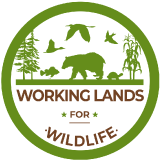-
 Rainwater Basin Joint Venture
Rainwater Basin Joint Venture
-
by
Rhishja Cota
—
published
Sep 29, 2022
—
filed under:
Wildland Fire,
Fire,
Rainwater Basin Joint Venture
The Rainwater Basin Joint Venture’s objective since 1992 has been to work with private landowners, agriculture producers, and conservation partners to ensure adequate wetland habitat for the migrating birds that depend on this region.
Located in
LP Members
/
Organizations Search
-
Remote Sensing
-
by
Tab Manager
—
published
Aug 31, 2022
—
filed under:
Fire,
Wildfire,
Wildland Fire Research Journals,
Wildland Fire
Remote Sensing is a peer-reviewed, open access journal about the science and application of remote sensing technology.
Located in
Resources
/
Research
/
Research Journals
-
 Ruffed Grouse Society | American Woodcock Society
Ruffed Grouse Society | American Woodcock Society
-
by
Web Editor
—
published
Jun 30, 2020
—
last modified
Apr 16, 2024 03:13 PM
—
filed under:
Wildlife,
RGS,
Ruffed Grouse Society,
SE FireMap,
Conservation,
Wildland Fire,
American Woodcock Society
Established in 1961, the Ruffed Grouse Society is North America’s foremost conservation organization dedicated to preserving our sporting traditions by creating healthy forest habitat for ruffed grouse, American woodcock and other wildlife. RGS works with landowners and government agencies to develop critical habitat utilizing scientific management practices.
Located in
LP Members
/
Organizations Search
-
 Sandhills Prescribed Burn Association
Sandhills Prescribed Burn Association
-
by
Rhishja Cota
—
published
Apr 16, 2024
—
last modified
Apr 16, 2024 03:09 PM
—
filed under:
Wildland Fire,
SE FireMap,
Sandhills Prescribed Burn Association,
Prescribed Burn Associations
The Sandhills Prescribed Burn Association (SPBA) was created to assist landowners in restoring one of the most biologically diverse and culturally rich landscapes that once covered 90 million acres in the Southeastern US.
Located in
LP Members
/
Organizations Search
-
 Sandhills Task Force
Sandhills Task Force
-
by
Rhishja Cota
—
published
Sep 29, 2022
—
filed under:
Wildland Fire,
State,
NGO,
Sandhills Task Force
The Sandhills Task Force (STF) is a non-profit organization consisting of a 16-member board of Sandhill ranchers and conservation agencies. The organization’s focus is on affecting sound environmental and economic practices in the Sandhills of Nebraska.
Located in
LP Members
/
Organizations Search
-
 Santa Rosa-Paradise Restoration
Santa Rosa-Paradise Restoration
-
by
Rhishja Cota
—
published
Oct 27, 2022
—
filed under:
Wildland Fire,
Research
The Santa Rosa-Paradise landscape is a priority landscape under Nevada Division of Forestry's (NDF) Forest, Range and Watershed Action Plan.
Located in
Resources
/
…
/
Projects
/
Wildfire
-
 Scattered Lands Hazardous Fuels
Scattered Lands Hazardous Fuels
-
by
Rhishja Cota
—
published
Oct 27, 2022
—
filed under:
Wildland Fire,
Research
The Scattered Lands Hazardous Fuels project focuses on 173,942 acres of high-risk forestlands in North Idaho.
Located in
Resources
/
…
/
Projects
/
Fire-Community & Infrastructure
-
SE FireMap
-
by
Web Editor
—
published
Dec 30, 2020
—
last modified
Dec 12, 2023 08:43 PM
—
filed under:
SE FireMap,
Wildland Fire,
SEFireMap,
WLFW,
News
An improved system for mapping fires across the U.S.
Located in
News & Events
/
News Inbox
-
SE FireMap at The Longleaf Alliance Conference
-
by
Web Editor
—
published
Oct 01, 2024
—
last modified
Oct 01, 2024 11:54 PM
—
filed under:
SE FireMap,
News,
WLFW,
Landscape Partnership,
Wildland Fire
Come say hello to the SE FireMap team at the Biennial Longleaf Conference October 8th-11th, 2024!
Located in
News
-
 SE FireMap Phase 2 Proposal - Public Version
SE FireMap Phase 2 Proposal - Public Version
-
by
Lucas Furman
—
published
Jan 11, 2023
—
last modified
Oct 01, 2025 12:05 PM
—
filed under:
SE FireMap,
Wildland Fire,
SE FIreMap 2.0
Phase II "Development" proposal jointly submitted by Tall Timbers Research Station and USGS. Financial information has been removed to accommodate sharing. This proposal was approved for funding by NRCS via direct agreements in November, 2022. Initial deliverables are anticipated in March, 2023 and the agreement performance period ends in 2026.
Located in
Resources
/
SE FireMap Documentation
/
SE FireMap Project Process Documents


